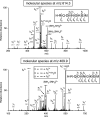Multiple, non-conserved, internal viral ligands naturally presented by HLA-B27 in human respiratory syncytial virus-infected cells
- PMID: 20081153
- PMCID: PMC2938088
- DOI: 10.1074/mcp.M900508-MCP200
Multiple, non-conserved, internal viral ligands naturally presented by HLA-B27 in human respiratory syncytial virus-infected cells
Abstract
Cytotoxic T lymphocyte (CTL)-mediated death of virus-infected cells requires prior recognition of short viral peptide antigens that are presented by human leukocyte antigen (HLA) class I molecules on the surface of infected cells. The CTL response is critical for the clearance of human respiratory syncytial virus (HRSV) infection. Using mass spectrometry analysis of complex HLA-bound peptide pools isolated from large amounts of HRSV-infected cells, we identified nine naturally processed HLA-B27 ligands. The isolated peptides are derived from six internal, not envelope, proteins of the infective virus. The sequences of most of these ligands are not conserved between different HRSV strains, suggesting a mechanism to explain recurrent infection with virus of different HRSV antigenic subgroups. In addition, these nine ligands represent a significant fraction of the proteome of this virus, which is monitored by the same HLA class I allele. These data have implications for vaccine development as well as for analysis of the CTL response.
Figures


Similar articles
-
The viral transcription group determines the HLA class I cellular immune response against human respiratory syncytial virus.Mol Cell Proteomics. 2015 Apr;14(4):893-904. doi: 10.1074/mcp.M114.045401. Epub 2015 Jan 29. Mol Cell Proteomics. 2015. PMID: 25635267 Free PMC article.
-
The HLA-DP peptide repertoire from human respiratory syncytial virus is focused on major structural proteins with the exception of the viral polymerase.J Proteomics. 2020 Jun 15;221:103759. doi: 10.1016/j.jprot.2020.103759. Epub 2020 Mar 31. J Proteomics. 2020. PMID: 32244010
-
Unusual viral ligand with alternative interactions is presented by HLA-Cw4 in human respiratory syncytial virus-infected cells.Immunol Cell Biol. 2011 May;89(4):558-65. doi: 10.1038/icb.2010.125. Epub 2010 Oct 26. Immunol Cell Biol. 2011. PMID: 20975736
-
HIV-1 proteins in infected cells determine the presentation of viral peptides by HLA class I and class II molecules and the nature of the cellular and humoral antiviral immune responses--a review.Virus Genes. 1994 Jul;8(3):249-70. doi: 10.1007/BF01704519. Virus Genes. 1994. PMID: 7975271 Review.
-
Antigenic and genetic variation in human respiratory syncytial virus.Pediatr Infect Dis J. 2004 Jan;23(1 Suppl):S19-24. doi: 10.1097/01.inf.0000108189.87181.7c. Pediatr Infect Dis J. 2004. PMID: 14730266 Review.
Cited by
-
Modulation of Natural HLA-B*27:05 Ligandome by Ankylosing Spondylitis-associated Endoplasmic Reticulum Aminopeptidase 2 (ERAP2).Mol Cell Proteomics. 2020 Jun;19(6):994-1004. doi: 10.1074/mcp.RA120.002014. Epub 2020 Apr 7. Mol Cell Proteomics. 2020. PMID: 32265295 Free PMC article.
-
Natural HLA-B*2705 protein ligands with glutamine as anchor motif: implications for HLA-B27 association with spondyloarthropathy.J Biol Chem. 2013 Apr 12;288(15):10882-9. doi: 10.1074/jbc.M113.455352. Epub 2013 Feb 19. J Biol Chem. 2013. PMID: 23430249 Free PMC article.
-
Multiple viral ligands naturally presented by different class I molecules in transporter antigen processing-deficient vaccinia virus-infected cells.J Virol. 2012 Jan;86(1):527-41. doi: 10.1128/JVI.05737-11. Epub 2011 Oct 26. J Virol. 2012. PMID: 22031944 Free PMC article.
-
A viral, transporter associated with antigen processing (TAP)-independent, high affinity ligand with alternative interactions endogenously presented by the nonclassical human leukocyte antigen E class I molecule.J Biol Chem. 2012 Oct 12;287(42):34895-34903. doi: 10.1074/jbc.M112.362293. Epub 2012 Aug 27. J Biol Chem. 2012. PMID: 22927436 Free PMC article.
-
Novel HLA-B7-restricted human metapneumovirus epitopes enhance viral clearance in mice and are recognized by human CD8+ T cells.Sci Rep. 2021 Oct 21;11(1):20769. doi: 10.1038/s41598-021-00023-0. Sci Rep. 2021. PMID: 34675220 Free PMC article.
References
-
- Shastri N., Schwab S., Serwold T. (2002) Producing nature's gene-chips: the generation of peptides for display by MHC class I molecules. Annu. Rev. Immunol. 20, 463–493 - PubMed
-
- Del-Val M., López D. (2002) Multiple proteases process viral antigens for presentation by MHC class I molecules to CD8+ T lymphocytes. Mol. Immunol. 39, 235–247 - PubMed
-
- Parker K. C., Bednarek M. A., Coligan J. E. (1994) Scheme for ranking potential HLA-A2 binding peptides based on independent binding of individual peptide side-chains. J. Immunol. 152, 163–175 - PubMed
-
- Rammensee H., Bachmann J., Emmerich N. P., Bachor O. A., Stevanoviæ S. (1999) SYFPEITHI: database for MHC ligands and peptide motifs. Immunogenetics 50, 213–219 - PubMed
-
- Bjorkman P. J., Saper M. A., Samraoui B., Bennett W. S., Strominger J. L., Wiley D. C. (1987) Structure of the human class I histocompatibility antigen, HLA-A2. Nature 329, 506–512 - PubMed
Publication types
MeSH terms
Substances
LinkOut - more resources
Full Text Sources
Medical
Molecular Biology Databases
Research Materials

